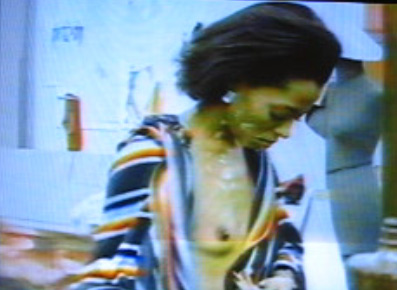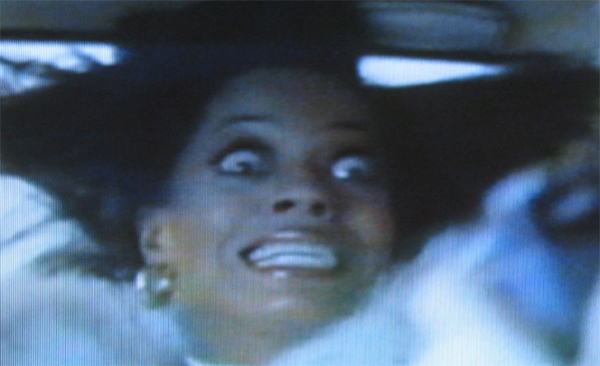
As Mahogany begins: it's not that bad. OK, the shot of ultra successful fashion designer Tracy Chambers (Diana Ross) going back in time to become the girl in the hood is a might cheesy, but there was a nice subtle touch when Tracy is on the elevated train and gets inspiration for a design of her own from a graffiti artist she spies outside the window. Tracy's character is revealed a bit more as the movie continues (home life, work life, studies, meeting future love Brian Walker) but then IT happens: Tracy arrives to work late and is berated by her boss (Nina Foch) as they walk through the workplace to meet photographer Sean McAvoy (Anthony Perkins). The scene ends at the point I've taken the screen shot on the top and the film cuts to a shot of Ms. Ross and Ms. Foch entering the room (screen shot on the bottom).

Did they just change clothes? Ross is wearing a red dress and Foch a blue dress in the first scene. But when they walk into the room, Ross is in blue and Foch in red. The clothes are different but Ross still carries her notebook and Foch seems to be wearing the same necklace. There was no reference to the quick change or to it being a different day. The change was subtle but this was bad subtle. They just walk in the room wearing different dresses? Oh, yes, happens all the time. Please, even bad movies need some semblance of character motivation. I kept rewinding and watching it again. (And I was watching my VHS tape which takes time and precision to rewind.)
OK, all bets are off. In order, here goes:
- Frame Composition: Tracy (Diana Ross) and Brian (Billy Dee Williams) have a fight concerning the use of poor black people as background in a high fashion photo shoot. The two actors are on opposite sides of a chain link fence during the fight. Between the two, center screen, is an extra that plays the whole scene with tennis match eyes, moving them back and forth from Ross to Williams and back to Ross until Williams ultimately walks off. The extra steals the scene.

- Classic of the Genre: The photo montage of Ross becoming a huge fashion model is akin to Patty Duke's nightclub singer training montage from Valley of the Dolls.
- Tracy as a Model: It is absurd for Tracy to decide to wear her own design on a job as a fashion model. She has been hired to wear clothes for photographs. The right thing for her to have done was to ask Sean as a friend to photograph her later in some of her designs, you know, for fun. Her behavior is selfish and ego-centric.
- Tracy as a Designer: Tracy chooses to wear the most ridiculous design in her collection for her Italian auction 'debut'. Now I've heard of haute couture but who is Tracy of Chicago designing for? Japanese geisha space aliens? Why didn't she surprise everyone with a nice dress like the one she wore to the party afterwards? I guess if she had worn a different dress, it would've been a different movie. Her behavior is selfish and ego-centric.
- Anthony Perkins Plays a Freak...Again: Sean McAvoy is not sympathetic and that creepy Perkin's smile during the gun fight is truly revolting. McAvoy represents a heterosexual male's fear of turning gay and even when he attempts to kill that side he can't or doesn't. Oh, Mahogany, who knew you had that depth to you?
- dianipple Alert: Ross's breakdown after Brian no spoiler here is laughable with her dripping hot wax all over her naked body. More importantly though is that, when she later puts on her bathrobe, you see her left 'dianipple' and applicable boobage.

- Diana Does Diana and...Lucy: The car crash scene with Ross doing her infamous Take the picture, Sean face is frightening in its similarity to the strait jacket shot from Lady Sings the Blues.

It is also very similar to the even more infamous Lucille Ball spider face.
- Success is nothing without someone you love to share it with Billy Dee Williams is good as Brian, the up and comping alderman. He delivers the film's iconic line credibly despite its hoakiness. Ross, on the other hand, is initially wooden. Her performance seems to come into its own when Brian arrives in Rome. This and her new found success inspires diva-esque behavior that seems to impel her with energy. And even though Ross twirls great in one scene in the graffiti-inspired dress she designed that doesn't make for a very good movie - even a good 'bad' movie.
- Do You Know Where You're Going To? You do get to hear the lovely theme from Mahogany twice. It really is the best part of the movie.
- VERY ENDING SPOILER: Ross proclaims to Brian at film's end, "Mister, you got my vote." So Tracy moves back to Chicago to be with her man and to whom is she gonna sell her clothes? Who wants horrible dresses that look like the inside of space ships? Or now success will mean something because she has someone she loves to share it with.
After Mahogany, I decided to quench my thirst for the other side of the boobage scale and watch Pamela Anderson (or as she is billed on the DVD, Pamela Anderson Lee) in Barb Wire. Like Ross in Mahogany, Lee gives her audience what they want right off the bat; over the credits, she does a water dance a la Flashdance, with her tits on high. (And they are quite a pair.) A hot version of Word Up performed by Gun plays over the performance. (In Mahogany, Ross sings her #1 hit over the credits. That's what her fans want. Am I the same person?) You might have to agree to being over 18 if you decide to view the Anderson nudie clip below on YouTube. Seriously.
It's two weeks later and I'm still trying to finish Barb Wire. (Boobage is not always enough.) I can't seem to get past the first thirty minutes but today I will - otherwise, this entry won't be published. I'm back where the soldier asks Barb to dance. I never realized until now that the song the goth chick band, Die Cheerleader, plays in this scene as Barb is dancing barefoot is indeed Dancing Barefoot, a song by Patti Smith. Such subtle character development in a comic book movie!

Anderson Lee's prowess as an actress is revealed in the scene where she discovers her blind brother's dead body. (I laughed. I cried. It became a part of me.) Anderson Lee is also suitably droll when her ex-man introduces her to his new wife, a scientist. Barb retorts, "How impressive. I'm sure you'll have very strong, smart children." The best line though goes to Xander Berkeley as Police Chief Willis. After Steve Railsback (as a Congrssional commander) rails, "If Cora D escapes, I will personally rip your heart out of your ass and stuff it back down your throat," Willis deadpans, "That's not very sanitary."
It is also interesting to note that scientist/wife Cora D has had her face altered; the before picture shown to Barb reveals a woman with very Negroid features.

The after of Cora D is very light-skinned black actress Victoria Rowell. Now we can look deeply into this decision and decide that the creators of Barb Wire felt that dark-skinned black women are more intelligent but they needed a prettier, light-skinned black woman to bring in the bucks. Here they use the more mainstream, acceptable light-skinned black woman to propel the movie's story forward while the Negroid actress is relegated to a static picture. Why did the black-skinned actress have to become Michael Jackson? The bad guys made it a point to say that her face doesn't matter as they can tell her identity via a retinal scan. So why change her face at all? Or why couldn't Barb Wire herself be the new Cora D? (Pamela Anderson Lee is delightful as Stephen Hawkings!!)
I finally finished Barb Wire. Of course, all's well that end's well. Except of course for the blind brother, and the dark-skinned actress in the static picture. I haven't seen either since.
regarding mahogany where there is a change of clothes......its not a mistake....if you look at the previous scene, tracy's boss says that the following week, sean mcavoy is coming to their store...so when you see tracy and her boss in different outfits...it is the following week, not the same day.
ReplyDeleteGreat blog entry.
ReplyDeleteAbout "Barb Wire":
ReplyDeleteYou didn't have to call the black actress "Negroid", all you had to do was say she was black. "Negroid" makes her sound like some weird 3-pronged creature from outer space or something. Black people are human,too, you know. But, anyway, good observation about the change of the actresses' looks---that's typical Hollywood for you, unfortunately. I've never seen this film, and have only read about how bad it is, so I might take a peek at it, just to see exactly how horrible it is.
Liked Mahogany, and I've always liked that theme song---it's a well-written classic, straight-up.
I appreciate your comment but Negroid is not a bad word. It has a specific anthropological meaning. The difference I saw between the two actress's faces is skeletal and that's what I described. Hollywood did the rest. (See http://en.wikipedia.org/wiki/Negroid.)
ReplyDeleteLove Mahogany's theme as well; that entire Ross album is a classic!